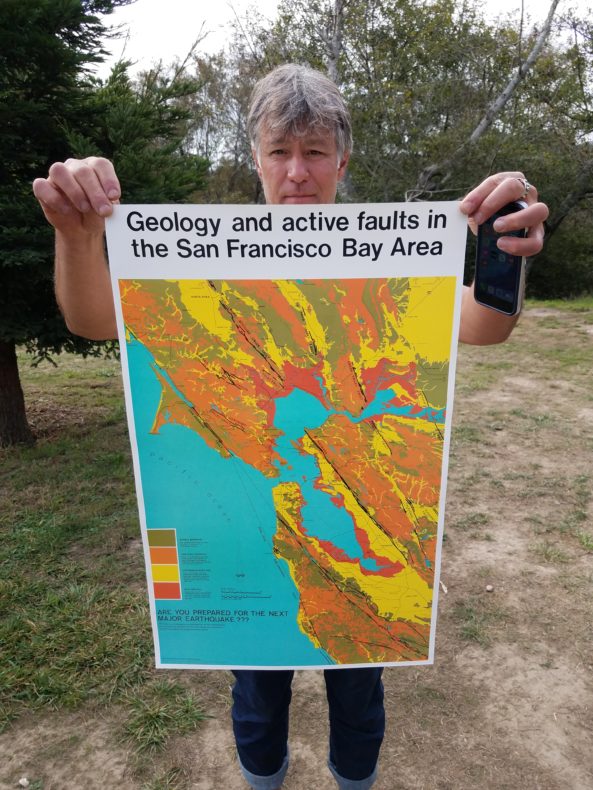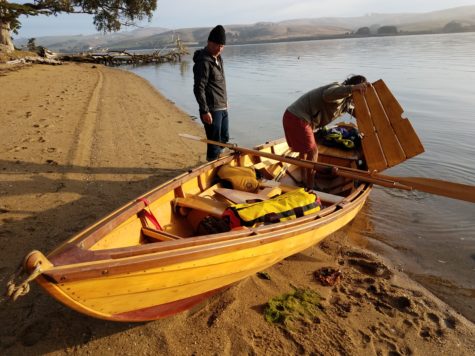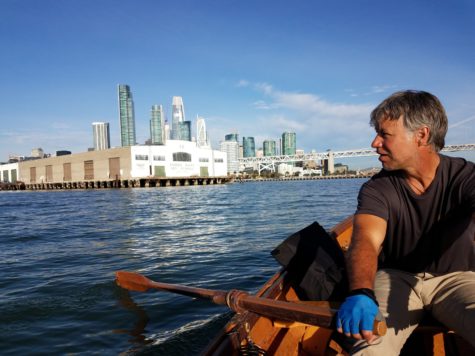
I walked along the beach a few days ago a quarter mile landward of the San Andreas fault zone. Surfers were swimming out and riding the curls back on the west side of San Francisco. Sets picked them up over the Pacific Plate and swept them onto North America. A hundred feet below, the fault lay buried under shifting sandbars and deeper layers of sediment, icing smoothed on day after day.
South of here stood the ragged projection of Mussel Rock, where the San Andreas fault continues from land into the sea, dipping under like a shark. To the north is the Marin Headlands where hills part, the fault making landfall again. An invisible boundary could be drawn between the two, passing through surfers lined up over the fault like iron filings to a magnet.
Things we take for granted, the earth moving under our feet, the heat down deep that drives the motion. This is why we are here. Without tectonics, this planet might not have life, at least not as we know it. By continuously supplying substrates and removing products, continental plates as they separate and collide create a geochemical cycle. Without tectonics to grind up mountain ranges, spitting volcanoes at the edges, there would be no crazy, colorful diversity from hummingbirds to the rainbows of minerals formed in oxygenated atmospheres.
The San Andreas fault, which runs from near Mexico to the sea just north of San Francisco, is the line between two of the larger global plates, which rub aggressively against each other, both heading the same general direction but at different speeds. For the last week I’d been paying homage to this fault by traveling with a friend along its trajectory where it passes through the Bay Area. Much of that course is by water, requiring the use of a craft. My friend, John, brought his sea-going dory for us to row the line. He called our journey ‘continental drifting,’ as if it were some new global sport and we were the only participants.
Crossing San Francisco Bay in the dory, we cheated a little. Not wanting to navigate open ocean off the coast where the fault runs, we bisected shipping lanes at the Golden Gate Bridge, dodging enormous container ships, and landed on the north side to meet a trailer and move to the next part of the fault. Where it runs the length of Tomales Bay, we rowed along with it, camping on a tanglewood beach on the Pacific Plate, rowing in for coffee the next morning on the North American Plate.

We often travel by geology, flying to cities located near mineral or coal resources, moving along roads that mirror fault lines. We are obedient to the planet, and most of the time unaware. For John and me with the dory, it felt like jumping into a Mardi Gras procession. A musician we happened to meet along the way, Ramblin’ Jack Elliot, who lives along the San Andreas fault north of San Francisco, told us, “Be careful tapping your feet too hard.”
It is worth noting that human industry has altered tectonic balances worldwide by adding and subtracting mass, from ice loss to ore extraction. A 7.9 earthquake in China’s Sichuan province killed an estimated 80,000 people in 2008. The trigger is believed to be 320 million tons of water, which had been filling the Zipingpu Reservoir over the previous two and half years. The reservoir sits on a fault line.
Most faults are not between colliding plates. They sit out in the open where the continental interiors shift and crack. I came to the San Andreas because it is one of the big ones. If you wanted to contemplate the writhing reality of this surface we call home, hills and fence lines offset from earthquakes, you’d be here.

At the end of our week, using a geologic fault map to find our way, John and I came back to where we started, where the San Andreas fault leaves Mussel Rock for the Pacific. Without the dory, my friend brought his surfboard and joined the small procession swimming into the waves. I walked on shore.
I couldn’t tell which was John anymore. They all looked like human seals lifting in the swells and gliding across overhead waves through the silvery air of sea mist. They weren’t busying their heads with tectonics. The earth, like our bodies, keeps working without concentration. But we change it as we go. Every decision adds or subtracts. Like Ramblin’ Jack said, you don’t tap your foot too hard on the San Andreas fault.
Pics by me.
Just happened to run into Ramblin’ Jack Elliot? Be a high light for most folks.
Great adventure.